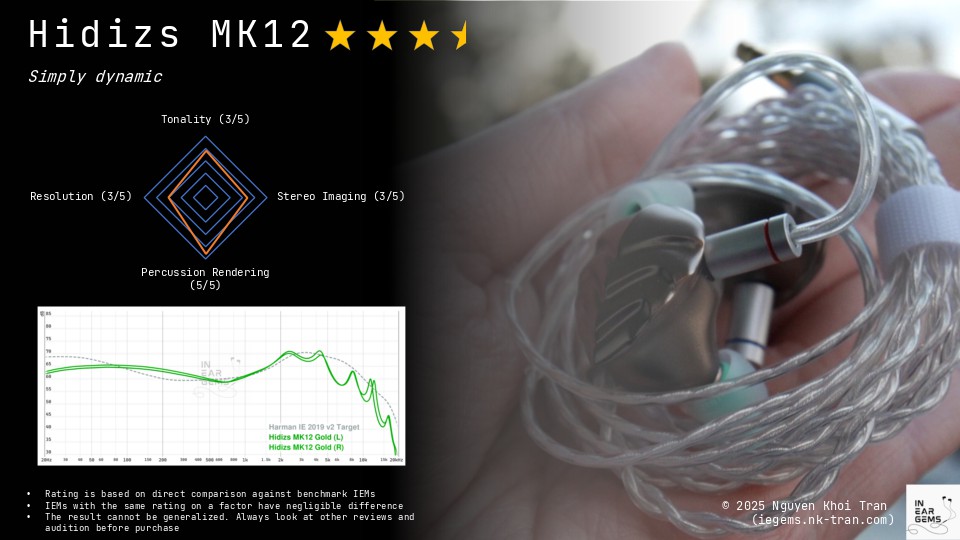Hidizs MK12 Turris - Simply Dynamic

I never set out to fall for a single dynamic driver IEM again: too many of them sound like budget boomboxes with delusions of grandeur.
This one doesn’t sound like a budget boom box. This one isn’t pretentious with all the science-driven tuning sermons. And, it’s bloody fun. Let’s take a look at the brand new Hidizs MK12.
Forewords
- What I look for in an IEM is immersion. I want to feel the orchestra around my head, track individual instruments, and hear all of their textures and details. I’m not picky about tonality, as long as it does not make the orchestra, violin, cellos, and pianos sound wrong.
- I rate IEMs within with a consistent scale from 1 (Poor) to 3 (Good) to 5 (Outstanding). An overall ranking of 3/5 or above is considered positive.
- Ranking list and measurement database are on my IEM review blog.
- The terminology for subjective impressions in this review is based on the Audio Wheel for reproduced sound defined in the technical report ITU-R BS.2399-0
- This review is based on a review sample from Hidizs (Thank you!). I have no affiliation with or financial interest in Hidizs.
- The unit will be launched on Kickstarter on 11/06/2025 at an early-bird price of USD$129. The full retail price will be USD$199. Unaffiliated link: Kickstarter
In the Box
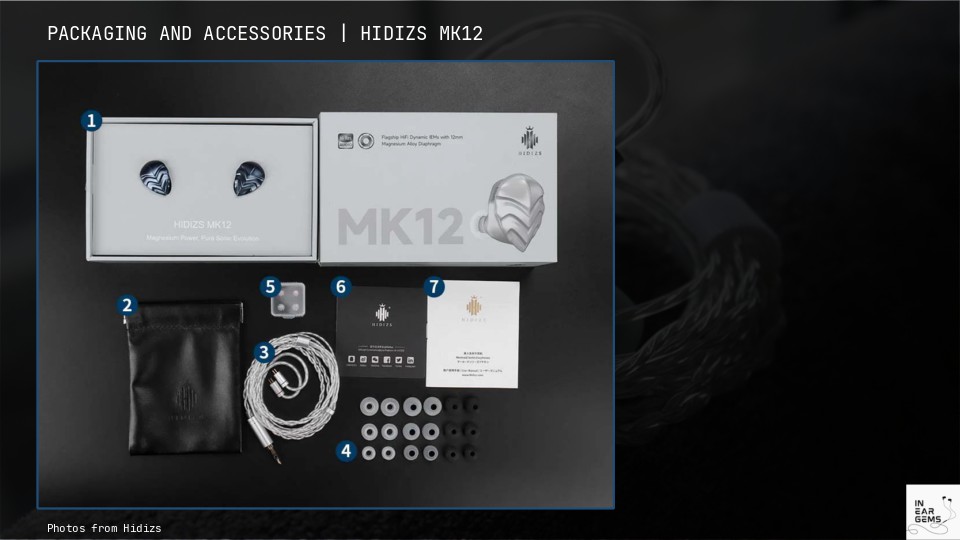
The MK12 arrives in a surprisingly compact and sturdy box with a rather, dare I say, elegant design. Inside, you’ll find the earpieces themselves carefully nestled alongside a cloth pouch for easy carrying. Sorry, no proper carrying case here. The cable included is a two-wire design with silver-plated cores, terminating in either a 3.5mm or 4.4mm jack depending on your order. It attaches via the familiar flush 0.78mm 2-pin connectors.
The extras don’t stop there: three sets of tuning nozzles—Gold, Silver, and Red—each fitted with different filter materials to subtly alter the frequency response of the IEM, offer some degrees of customization. On top of those, you get nine sets of eartips in three different shapes and sizes. Rounding off the package is a user manual and a warranty card (let’s be perfectly honest, when was the last time you read those papers?)
General Information
The Hidizs MK12 Turris is a straightforward single dynamic driver (DD) IEM—a driver configuration as classical as they come, if a little old-fashioned. Hidizs, a Hong Kong-based maker best known for audiophile-grade digital players and USB DACs, has maintained a somewhat uneven IEM line over the years. That said, last year they impressed with two planar magnetic models, the MP145 and MP143, proving they can strike the right notes when they want to.
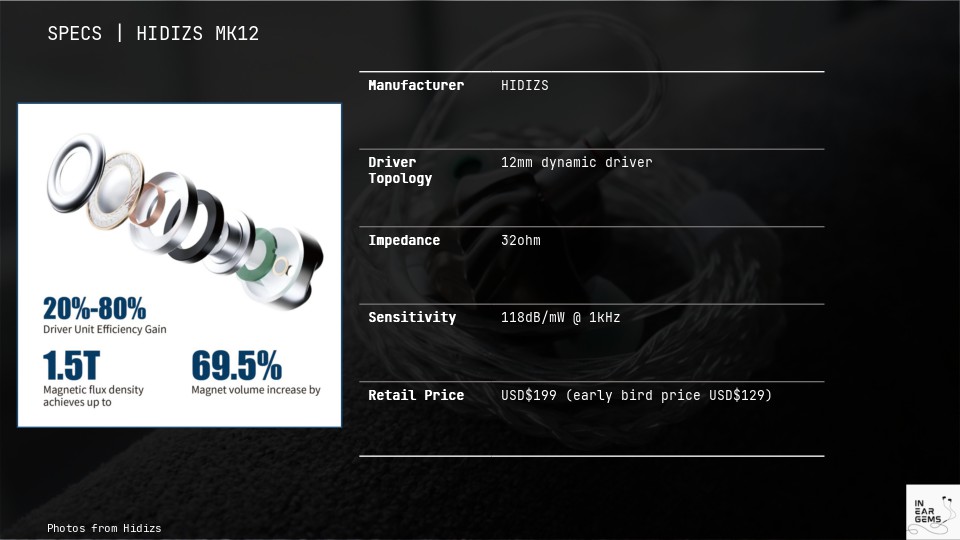
The MK12 sports a relatively large 12mm dynamic driver, featuring a diaphragm made from 91% pure magnesium shaped into an M-formed metal dome. It’s powered by a hefty 1.5 tesla external magnet. This design is reminiscent of the subwoofer in the legendary Sony IER-Z1R and the “ECLIPSE” driver used by the more affordable Dunu Falcon Ultra—an IEM we’ll be revisiting later in this review. The driver is sensibly rated at 32 ohms, a sweet spot that won’t overly tax your amplifier yet avoids impedance mismatch headaches. Its sensitivity sits at a fairly high 118 dB/mW, which means some source devices might reveal their noise floors. Harmonic distortion clocks in below 0.3% at 1 kHz, reassuringly low for a dynamic driver setup.
In terms of design, the MK12’s earpieces are CNC-machined both on the faceplate and the body, including the cavity housing the driver. At 19 grams each, they’re on the heavy side for IEMs, so don’t expect to forget you’re wearing them. The faceplate takes inspiration from the Turritopsis dohrnii—the immortal jellyfish—which is as charmingly pretentious as it sounds. The tuning nozzles screw on and off, each containing different foam and filter elements to tweak the sound signature. Their 5.9mm widest diameter and 4.1mm length are pretty ordinary measurements, meaning they’ll likely accommodate most tips without fuss. Finally, the usual detachable cable arrangement uses the widely adopted 0.78mm 2-pin connectors, ensuring easy swapping or replacement.
Experience
So, is the Hidizs MK12 any good? I’ve spent the better part of the last two weeks daily driving these IEMs to find out. My testing setup centred around the gold nozzles, which are the default tuning option Hidizs ships with. That choice wasn’t arbitrary—if their engineers are confident enough to make this the standard configuration, it makes sense to judge the IEM on their preferred sound. For eartips, I went with a new set of aftermarket ones that Hidizs plans to sell as accessories. They’re soft silicone and admittedly a bit flimsy, but that softness turns out to be their saving grace—they’re surprisingly comfortable. To keep things grounded, I stuck to the stock cable and pouch, reflecting the experience of a casual user who isn’t keen on splashing out on aftermarket gear. As for sources, my trusty Luxury & Precision W4 USB DAC dongle plugged straight into my desktop PC was the primary driver. When possible, I also paired MK12 with Hiby R6 Pro Max music player and HiBy FD5 desktop amplifier.
When it comes to physical handling, the MK12 is a mixed bag. The stock cable is a constant source of annoyance. It’s too flimsy, and the coiled section near the earhooks is overzealous, turning the cable into a tangled mess every time I fish the IEMs out of their pouch. It gets so bad I’ve found the two earpieces knotted together on more than one occasion. That’s a frustrating start to any listening session. The pouch, by contrast, is a quiet success. It’s simple, well-lined, and features a snap-open closure that stays reliably shut inside a briefcase. While not as luxurious as the bulky leather cases I favour for other IEMs, it’s a refreshing space saver.
The earpieces themselves feel hefty in the hand—19 grams each isn’t light—but once nestled in the ear, their weight becomes a non-issue. The clever contours on the side facing your ear, combined with the nozzle angle and modest nozzle size, do a fine job of keeping the MK12 comfortable. My initial worry was about the new eartips feeling flimsy enough to fail at creating a proper seal; surprisingly, they seal well, isolate noise decently, and ultimately are key to the sustained comfort I’ve had with the MK12.

Not everything is smooth sailing, though. The faceplate design has some bothersome quirks. For starters, the faceplate is physically larger than the earpiece body itself, which is odd and problematic. Because of its size, the 2-pin connectors don’t sit flush against the body, leading to cables putting awkward pressure on the pins. On close inspection, the pins on my cable have even bent slightly as a result. Aesthetically, the faceplate falls short as well. The CNC machining gives it shape and contours, but those contours aren’t sharp or precise enough, resulting in an overall look more akin to a cheap keychain souvenir than an intricate IEM faceplate. If I’m honest, it reminds me less of the immortal jellyfish it’s supposed to evoke and more of Blue Beetle’s backpack from Marvel comics. A punchier design with sharper edges, deeper curves, or a layered metal finish like Hidizs’s MS5 could have lifted the visual appeal significantly. As it stands, I spend little time admiring or holding the earpieces—I’m more interested in getting them in and out of my ears as quickly as possible.
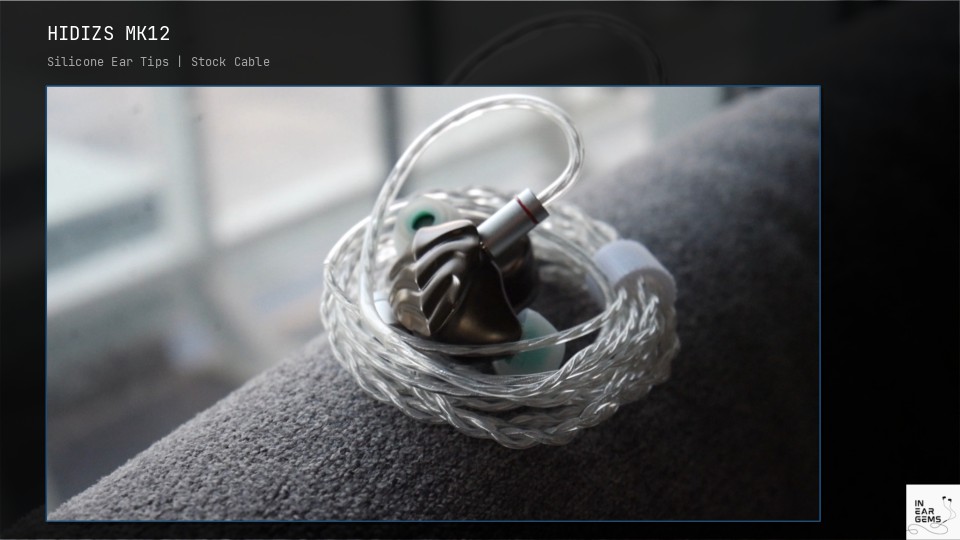
Fortunately, where it truly matters—in the sound—the Hidizs MK12 holds its own rather well. To get a grip on its tonal character, it helps to take a quick detour through the typical territory of single dynamic driver IEMs. By their nature or by market convention, single DD IEMs often sport a familiar “V-shaped” signature. They tend to feature a strong mid-bass that punches like the “boom boom” of drums rather than the low-level rumble of EDM. Add to that prominent peaks around 2.5 kHz and 5 kHz—what I call the “cat ears tuning”—along with some peaks and dips above 5 kHz before fading in the upper treble. This kind of tonal profile clashes somewhat with the current breed of “science-driven” tuning that dominates online forums. There, “experts” armed with frequency response measurements insist that a “good” IEM should showcase a defined bass shelf peaking in the subbass but controlling midbass, a flat midrange from 250 Hz to 1 kHz, a smooth 8 to 10 dB rise up to 3 kHz, a gentle dip around 6 kHz to tame transients, and an even treble response out to 20 kHz.
Faced with that mold, manufacturers of single DD IEMs tend to choose between two approaches. Some attempt to bend their dynamic drivers into the prescribed scientific shape, often producing beautifully measured curves on paper. In practice, though, these IEMs can sound blunt and uninspiring—“meh” is the polite term. Others accept the DD’s characteristic V-shape as an anachronism, but then face criticism for producing a sound that’s too boomy, shouty, or harsh for modern tastes.
Then there’s a third path, trodden by the likes of Hiby with their Yacht10, and now Hidizs with the MK12. It’s a middle ground: retain the essence of the single DD signature without pretense, but sand off some of the abrasive edges. That, my readers, is precisely how I’d describe the MK12’s sound.

Tonal balance-wise, there isn’t much subtlety to discuss. The MK12 sports a relatively tamed V-shaped signature. The midrange tilts slightly toward the upper mids but retains enough warmth and thickness to stop vocals or instruments sounding thin or overly bright. Male vocals, such as Johnny Cash’s baritone, and lower-register instruments like cellos are rendered in an adequate, if unremarkable, manner. Vocals and instruments sit forward in the mix, close enough to grab your attention. Upper midrange emphasis grants clarity and the necessary bite for voices to cut through, but importantly, Hidizs tames the critical 6 kHz region compared to Hiby’s more aggressive Yacht10, so harshness is kept at bay even on brighter tracks like Ed Sheeran’s Shivers. That said, cymbals and hi-hats, along with treble extension in general, take a back seat.
Bass-wise, guitars and drums jump forward in the mix and present a boomy character that might catch you off-guard switching from a more neutral IEM.
Not everything is rosy, however. The way Hidizs shapes the midrange, paired with a restrained treble approach, results in certain instruments—brass, in particular—sounding muted, even somewhat boxy. The Tokyo Kosei Wind Orchestra album In Suisougaku loses some of its naturalness and interest on the MK12. Cellos fall into the “just okay” category, lacking a bit of power and thickness. Nothing like the depressingly flat result you get from an over-Harman-tuned model, but still disappointing. On the plus side, pianos sound balanced and lively. The left-hand bass lines can overpower the right slightly, but I prefer it that way—it’s better to catch the bass lines than miss them. Still, the overall tuning could benefit from more refinement.
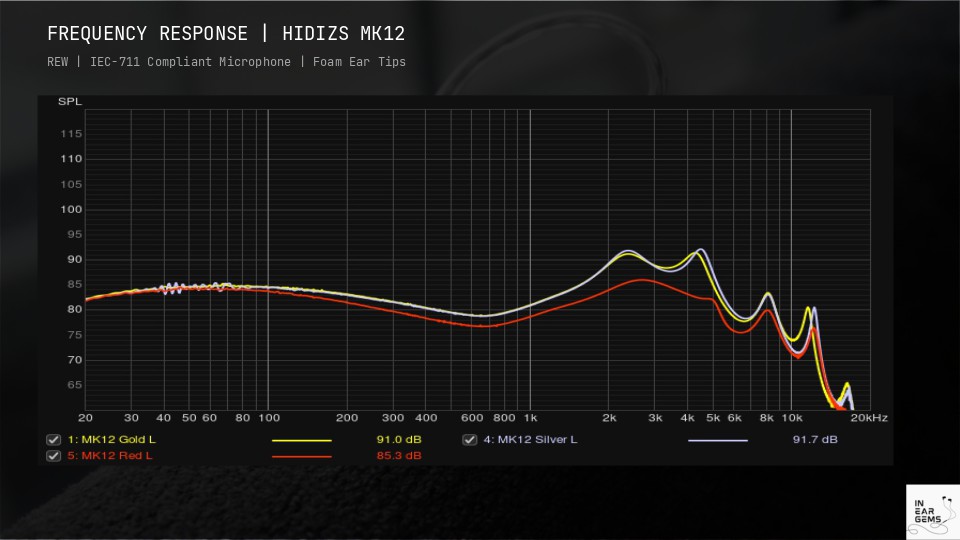
You might be thinking, “Well, isn’t it lucky that Hidizs includes interchangeable nozzles for tuning?” And yes, it is a clever solution. It’s interesting how subtle tweaks on a frequency graph translate into significant audible changes. Yet, those changes are not all entirely beneficial. Take the silver nozzles, for example. The slight bump in upper mids pushes the tonal balance over the edge for me, turning the midrange hollow and somewhat radio-like. Voices gain presence but lose body, and a mild harshness creeps in. Once you notice these flaws, it’s hard to ignore them. On a positive note, the soundstage gains some vertical height, and brass instruments acquire the treble “bite” necessary to sound more lifelike.
Switching to the red nozzles brings a notable volume drop due to the dampened high frequencies, as confirmed by measurements at equal input volume. Cranking up the volume inevitably boosts bass levels, resulting in a perceived bass lift. Midrange thickens noticeably, with Johnny Cash’s baritone suddenly taking on a richer, more commanding tone. Cellos suddenly gain authority and emotional weight. However, this comes at a cost. The bass loses some of its snappiness and punch, with beats turning into a mushy blob and the overall presentation becoming duller. Whether this tuning pleases you will depend on your recordings and preferences, but it’s definitely a trade-off in clarity and definition for warmth and body.
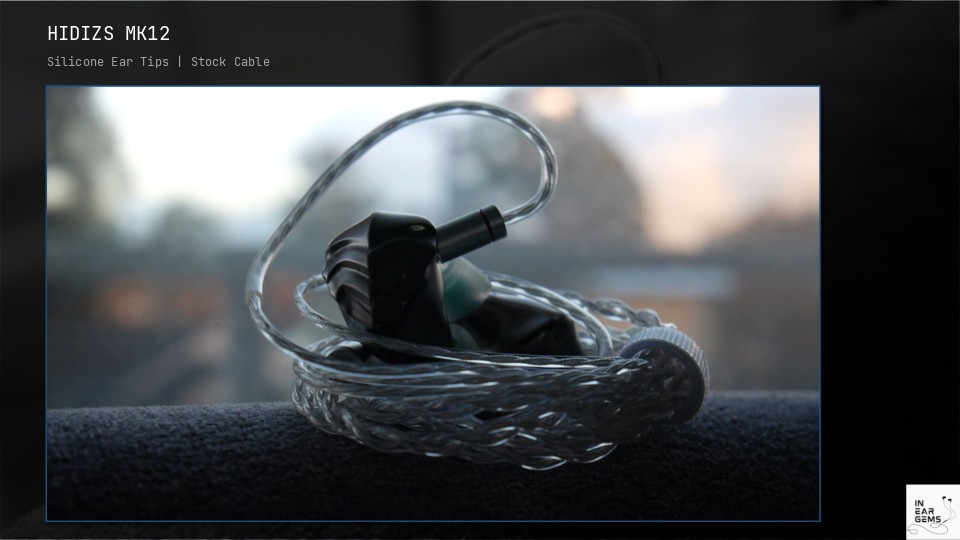
Switching back to the gold nozzles, let’s turn our attention to other aspects of the MK12’s sound. Resolution, for one, is better than you might expect from a single dynamic driver. Complex orchestral pieces come across as noticeably more incisive and better separated than with older single-DD standards like the Moondrop Aria 2021. Indeed, the MK12 approaches the resolution levels of hybrid IEMs like the Moondrop Blessing 2, which I consider something of a benchmark for well-resolved sound at this price range. Its micro-resolution—the fine details and subtle nuances—is solid for a single DD, hovering just a hair below the Blessing 2’s performance.
That said, it’s not an unblemished record. The MK12 struggles with tracks rich in low-frequency energy, such as the cello-heavy pieces by 2CELLOS. In those cases, the lower frequencies become congested, making it hard to separate individual instruments as everything starts feeling mushed together. So while the micro-resolution holds up reasonably well overall, it isn’t outstanding.
The soundstage and stereo imaging also warrant a mention: good, but not spectacular. The soundstage feels impressively wide, extending well beyond the ears, which is always welcome. Height illusions, however, depend heavily on which nozzle you use. Silver nozzles lift the soundstage upwards a bit, while the red nozzles seem to crush the vertical dimension entirely. Sound positioning is adequate—not pin-sharp but good enough to discern the overall location and direction of instruments, even in busier soundscapes. Depth perception, however, is where things falter. In FPS games, for instance, you can pinpoint sounds coming from the sides or behind you reasonably well, but front-facing sounds lack convincing depth or precise distance cues. This isn’t a failing unique to the MK12; depth illusions remain a notorious weak point for many IEMs.

The MK12’s real trump card is its bass response, which I would dare call close to perfection. The tuning unabashedly favours mid-bass punch over deep sub-bass rumble. This isn’t about making you feel bass vibrations in your chest—it’s about delivering that unmistakable “boom boom” that gets toes tapping. And boy, does it succeed. Whether it’s the train-like chugging of Johnny Cash’s Tennessee Three or the classic rock anthems like “Livin’ on a Prayer” and “It’s My Life,” you’ll find yourself tapping along involuntarily.
Where the MK12’s bass and dynamics really come alive is with powerful orchestral tracks, such as the epic F1 Theme composed and conducted by Brian Tyler. Although bass quantity and sub-bass boost on the graph are modest, the driver’s size and design allow it to convey a remarkable sense of weight behind each beat—air practically seems to be pushed against your ears. Combine this heft with finely tuned dynamics, where every bass hit snaps crisply from silence to peak volume, and the effect is genuinely breathtaking.
Frankly, the MK12’s bass and dynamics are so compelling that I’m almost willing to overlook some o its shortcomings elsewhere. This is, after all, the realm where a dynamic driver is meant to excel, and the MK12 struts its stuff with confidence.
Selected Comparisons
I ran these comparisons using the HiBy FD5 as my source, providing each IEM with the same potent amplification to maximise dynamics and impact.

MK12 vs Dunu Falcon Ultra: the Falcon Ultra puts in a disappointing performance when I A/B tested both with Brian Tyler’s F1 Theme. Simply put, the beats on the Falcon Ultra feel smaller and weaker. The explosive drive and energy that the MK12 delivers are just absent here. That said, the Falcon Ultra scores points for delivering more treble energy. Cymbals and hi-hats are far better defined and more articulate with the Falcon Ultra. Furthermore, it offers a tonality and tonal balance that feels more modern and arguably more accurate; vocals and instruments sound a touch more natural than on the MK12. So, declaring a clear winner proves tricky. The logical part of me leans towards the more refined, natural tuning of the Falcon Ultra, but my heart sides with the raw, primal energy of the MK12.
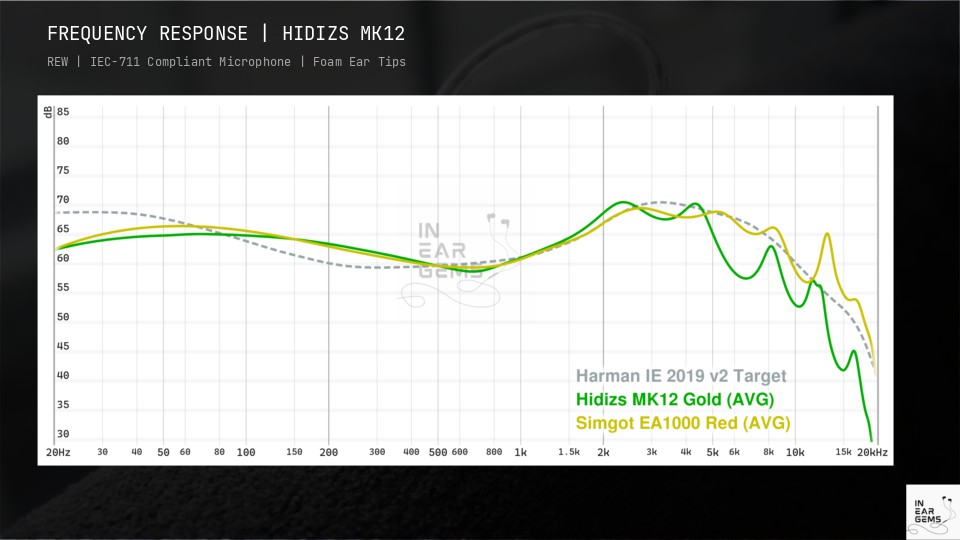
MK12 vs Simgot EA1000: Technically, the EA1000 isn’t a pure single dynamic driver since it includes a passive radiator acting as a second driver. But let’s not split hairs—the EA1000 is a spectacular DD-based IEM and merits comparison. Right from the start, the EA1000 flaunts its soundstage advantage thanks to the passive radiator. It’s tricky to articulate, but listening to the EA1000 is like having two extra speakers placed just outside your ears, creating an almost tangible sense that you can reach out and “grab” sound in the air around you. The MK12 holds its own in stage width but can’t replicate that effect. The EA1000 also boasts a more refined and modern midrange tuning: no hollowness, no boominess, just clean and correct. However, its cello recreational abilities lack a bit of grunt, similar to the MK12. Dynamically, the EA1000 fights harder than the Falcon Ultra and puts up a much more spirited contest, but it still falls short compared to the MK12’s punch. It’s got bass quality and dynamics that come close, but the overall bass volume is a few decibels too subtle to match the MK12’s power.
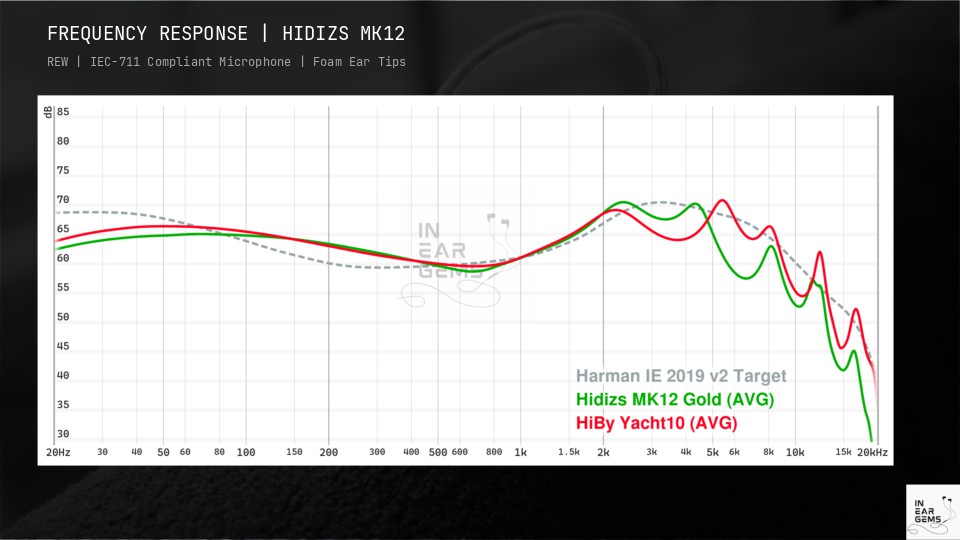
MK12 vs HiBy Yacht10: Comparing MK12 with the HiBy Yacht10 brings us to a rare equal in dynamic impact. The MK12 edges the Yacht10 with crisper bass attacks—just a shade more snap on each note. Meanwhile, the Yacht10 offers a touch more thickness and sheer power in its bass punch. It’s also the livelier, more eccentric competitor, thanks to an energised treble region. Cymbals and hi-hats sizzle more vividly, and the overall tonality is a bit different as a result. I personally prefer vocals and instruments on the Yacht10, which sound a bit more natural and involving. However, when stacked against the scientifically tuned Falcon Ultra and EA1000, both the MK12 and Yacht10 come off as somewhat unusual beasts. Regarding technical performance, I find the Yacht10 just a little better across the board. Neither has a particularly strong sense of depth, but the Yacht10 manages a slightly more enveloping spatial experience.
Detailed Analysis

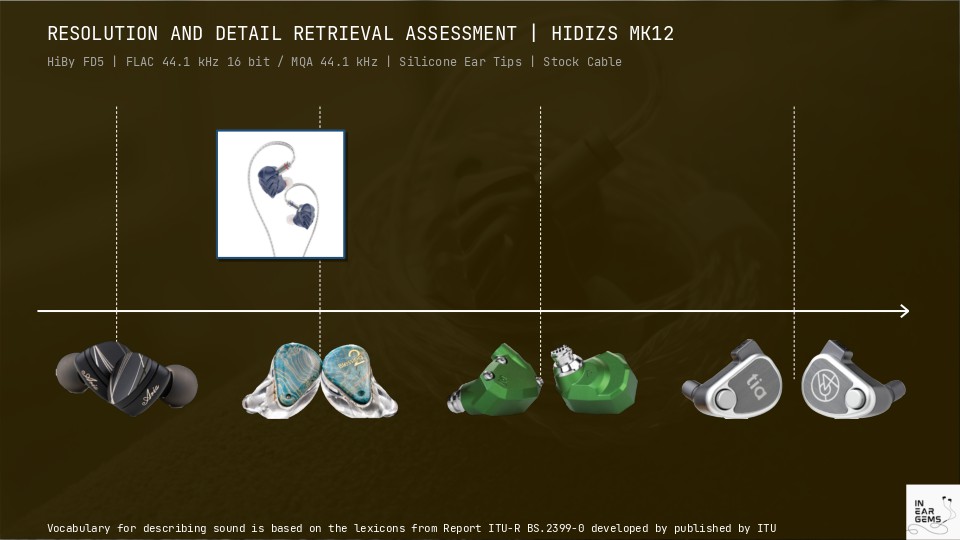
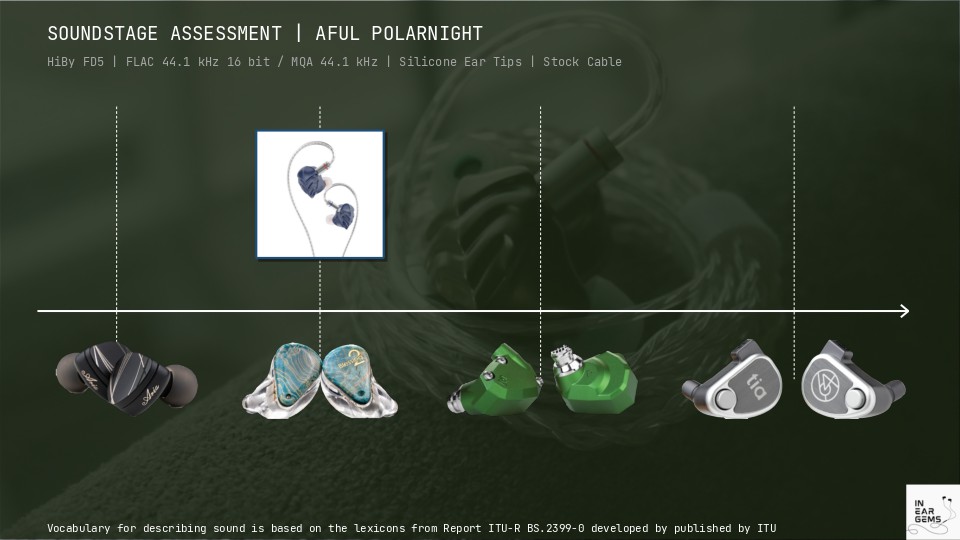
Conclusions
So, what do I make of the MK12? It’s refreshingly unpretentious—despite the lofty “Turritopsis dohrnii” inspiration and name. It’s honest, embracing the quirks and character of a single dynamic driver without pretending to be something more. More importantly, it’s a bloody fun listen. Sure, I have a fair few quibbles with the tonal balance and wish the technical performance could be a notch sharper. But most of these gripes vanish the moment the bass kicks in. Crucially, it delivers its toe-tapping fun without drowning the mix in a bloated bass shelf or turning everything into a rumbling mess. No, this is a straightforward, unadorned bass that gets the job done with integrity. To borrow a phrase from a certain Flying Dutchman: “simply lovely.”
